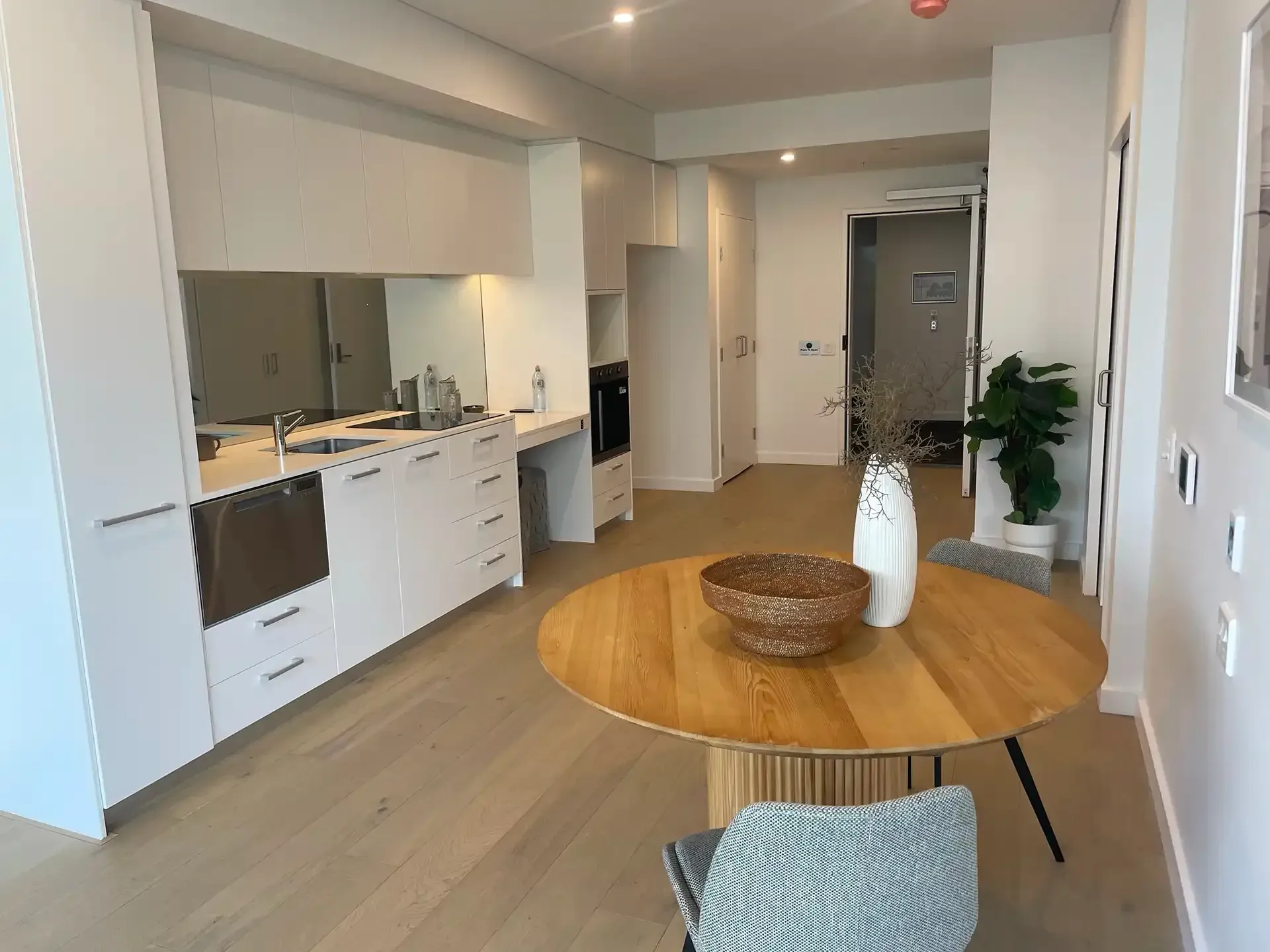Can Specialist Disability Accommodation help solve the housing crisis?
Helen Wood from Access Accommodation lets us in on the latest standards in Specialist Disability Accommodation (SDA) and how 'the politics' can be improved to address our housing crisis.
Anni says it has been a "game-changer" for her and Satala (known as ‘Suki’) to move into Specialist Disability Accommodation (SDA) as part of Suki’s NDIS plan. Since her scaffolder husband had a devastating stroke and became paralysed down one side, she has got her life back and he has regained his independence.
Living in a cramped, rented granny flat with no room to move around in a power wheelchair, Suki often had little desire to even get out of bed when his carers came to help him prepare for the day. Space was so confined that his carers had to move the bed to access him, and they struggled to transfer him into his wheelchair because it couldn’t fit into the bedroom.
Now, Suki zooms around his spacious apartment spending time in the kitchen helping Anni with his one good arm while watching the world go by from his balcony. He can even get out without assistance due to the accessible building's automated doors.

The impact on his mental health has been so positive he is even beginning to speak again, and Anni can leave the house to go shopping on her own knowing on-site staff are contactable via a pendant if he needs anything.
Suki and Anni’s story is just one of many for whom SDA has literally turned their life around. Without it, they would still be stuck in the confines of their granny flat facing a lifetime without hope of anything better.
SDA is available to eligible NDIS participants who need a built environment response to their disability needs––that's estimated to be around 6% of all participants. Eligible participants either have extreme functional impairment or high support needs, and often both. Typically, these are people who have experienced a catastrophic accident, acquired a brain injury, or have a congenital physical or intellectual disability or degenerative neurological condition.

There are four categories of design:
- Improved Liveability (IL)––similar to Silver Liveable Housing Design and suitable for people with sensory impairments and mobility issues causing falls risks.
- Robust––with reinforced building finishes to minimise property damage for people with behavioural issues.
- Fully Accessible (FA)––with additional space standards for wheelchair turning circles, wide doorways (900mm) and level thresholds for people using mobility aids such as walkers or wheelchairs. Kitchens have accessible benches, pull-out storage and appliances.
- High Physical Support (HPS)––similar to FA but with extra wide doorways (950mm) and smart home technology for people using power wheelchairs, and/or ceiling hoists for those who may need significant home automation and/or voice activated controls.

Accommodation may be single occupancy or shared; the latter being more suited to participants who don’t have the capacity to live alone or call for help when needed. These are typically houses with 24/7 in-house staff.
In contrast, apartment SDA generally has support staff in a separate unit in the same building with on-call arrangements, so care can be planned at certain times of the day but available 24/7 in between times and in emergencies.
The distinction of SDA rather than the former model of supported living in group homes is that accommodation and support are provided by different organisations of the tenants' choosing. This means they are no longer stuck in a closed system where, if they wanted to change their support provider who was also their landlord, they had to move homes.
Tenants pay the equivalent of a Community Housing Rent, being 25% of their Disability Support Pension, plus their entitlement to Commonwealth Rent Assistance. The task of providing SDA has been given to ‘the market’ with SDA payments going directly to the provider not the participant, designed to provide a reasonable return to institutional investors.
“The supply is unevenly distributed, and there are considerable vacancies in some areas. So, is the sector over-supplied?”
The market is delivering. After a slow start, 633 additional dwellings were enrolled in the September quarter across Australia, added to around 600 in the previous quarter. More recently, the National Disability Insurance Agency (NDIA) has been enrolling 350 dwellings a month. But despite this considerable progress, the supply is unevenly distributed, and there are considerable vacancies in some areas. So, is the sector over-supplied?
As with all things, the answer is not straightforward. Importantly, are the properties being built in the right locations, of the right type, for the right types of demand? And have investment decisions been made to try and optimise investor returns rather than respond to client needs and preferences?
Experience suggests, in truth, the answer is: many SDA developments are not ‘the right property in the right locations’.
There has been the unethical phenomenon of property spruikers enticing 'Mum and Dad' investors to build SDA in new release areas on the promise of government-backed funding streams and huge returns that have not eventuated. These properties are in areas with poor infrastructure and no established communities, so there’s little interest or demand from people with disabilities. In its own way, the market will sort these out over time, with empty properties being sold back into the residential market because investors will give up on finding suitable tenants and minimise their losses.
The ‘loss’ of SDA into the residential market in these circumstances is absolutely ironic because it means a supply of otherwise affordable housing for a very vulnerable group of people disappears in the home ownership/private rental market.
But these are the ‘bad apples’ in the SDA barrel.
On the other hand, there are many more well-located brand-new dwellings built in areas where, according to NDIS data, there is high demand for SDA. Many of these apartments and villas are sitting empty due to lack of NDIS participants with appropriate funding. Many of them are waiting for their applications to be processed and have been waiting for many months or even years.
What is needed is some ‘joined up’ government thinking
There is such a backlog of funding applications for SDA eligibility that it is not unusual for participants to wait six to 12 months to get an outcome. This can often be one they don’t find acceptable, and we regularly see NDIS participants forced to go through the even lengthier process of an internal appeal followed by a final appeal to the Administrative Review Tribunal (ART)––formerly the Administrative Appeals Tribunal––to get the funding for the housing configuration they prefer.
They may even have seen their 'Home and Living' application for SDA turned down because they've been erroneously deemed ineligible due to incorrect evidence supplied and/or a bureaucratic ‘box-ticking’ rather than taking a commonsense approach. This whole appeals process can take up to two years, while great quality SDA stock is sitting empty, creating massive stress for the applicants and financial headaches for the providers.
Putting more resources into getting these applications through the system and filling the SDA vacancies would alleviate pressure in a number of areas:
- Vulnerable NDIS participants have a permanent, safe and accessible home to live, maximising their independence and minimising their support needs;
- Vacancies in brand new stock can be filled quickly;
- Burnt-out carers trying to cope in substandard accommodation can recover and then return to the workforce;
- Social and community housing can be freed up for others in housing need;
- People with disabilities can be given the opportunity to re-enter the workforce once their permanent accommodation needs have stabilised.
SDA providers often house people who are moving out of social or community housing––following a spinal cord injury, stroke, or the worsening of a degenerative condition such as Parkinson’s disease or Multiple Sclerosis––because it doesn’t allow them to live independently. It is common to house clients who have moved out of inaccessible social housing with their partner or other family member, thereby creating a vacancy suitable for a family on the general housing waiting list. The result is often a great improvement in the independence of the person with disabilities who is housed so they can become economically active again.
Another example of a lack of coherent policy thinking is the disconnect between federal and state responsibilities. We don’t see the connection being made between the opportunity to approve funding for appropriate housing, which is already available, and the contribution to the alleviation of housing pressures nationally.
If the right resources were in place to assess NDIS participants’ housing needs quickly, the SDA market would be able to absorb these clients and free up their former housing for others––a logical means for addressing the national housing crisis. While some participants come from the family home after being cared for by (now ageing) parents, many others come from the private rental sector, or they may have been homeowners themselves before their disability. Whatever their previous accommodation, being offered an SDA home means their previous housing is returned to the relevant sector of the market.
Managers of social, community and affordable housing should be liaising with SDA providers as part of the process of helping their tenants when it is identified their housing needs are not being met in their current accommodation. A participant-focused approach should be taken to ensure the best long-term outcome for these tenants is achieved. This will be of mutual benefit to both the housing provider and the SDA provider.
Some community housing providers are also providers of SDA; in some cases, of unsuitable legacy stock, but others are building new accommodation and will, I’m hopeful, take the participant-focused approach to getting those internal transfers organised. This can only improve outcomes for people with disabilities.
Vacancies in SDA housing are not acceptable, and getting the right clients into the right homes can only be a positive contribution all round––to the people with disabilities, to SDA providers, and to the wider housing market.
Other articles you may like

We acknowledge the Wathaurong, Yuin, Gulidjan, and Whadjuk people as the traditional owners of the land where our team work flexibly from their homes and office spaces. Ahi Australia recognises Aboriginal and Torres Strait Islander peoples as the first inhabitants of Australia and the traditional custodians of the lands where we live, learn and work. Ahi New Zealand acknowledges Māori as tangata whenua and Treaty of Waitangi partners in Aotearoa New Zealand.
Copyright © 2023 Australasian Housing Institute
site by mulcahymarketing.com.au



